The B2B customer journey is a structured process that guides your buyers from recognizing a need to eventually becoming loyal advocates of your company.
Properly understanding each stage of this journey is essential when it comes to building stronger customer relationships and driving real business growth over the long term.
The Important Stages Of The B2B Customer Journey
Awareness
Providing high-quality content that actually addresses common pain points can really capture their attention.

It is important to remember this is your opportunity to introduce your company and demonstrate how you can solve their problems, laying the foundation for further engagement in the customer journey.
Consideration
Having case studies, product comparisons, and thought leadership content available can help establish your authority and provide clarity.
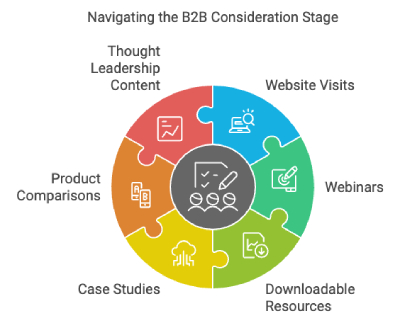
The goal is to show buyers that your solution is worth further investigation, helping them move closer to making a decision while positioning your brand as a trusted expert.
Evaluation
In the evaluation stage, buyers narrow down their choices and start comparing vendors. They are looking for more in-depth insights into your solution, such as product demos, pricing structures, and reviews from other clients. Differentiating your product by offering transparency and placing a focus on exceptional customer support can change the results that you get.
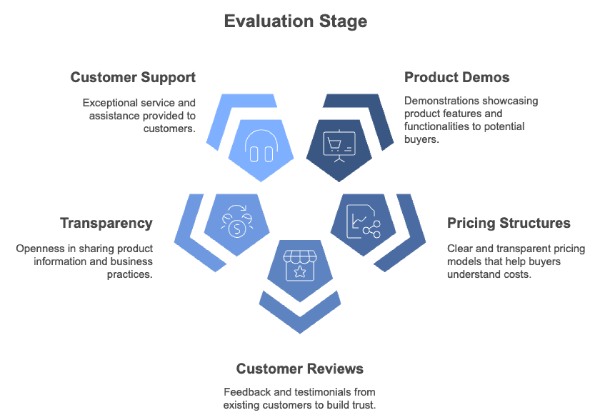
Trust and transparency are essential at this stage, as buyers want to feel confident that your product will deliver on its promises. Offering testimonials, third-party reviews, and a clear breakdown of benefits will help build trust and guide them toward making an informed decision.
Purchase
During the purchase stage, buyers have likely narrowed their options to one or two vendors and are ready to make a final decision. The focus now shifts to negotiations, pricing discussions, and contract terms.
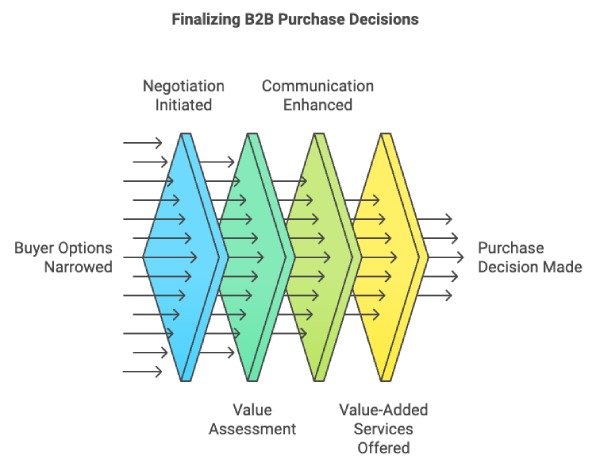
At this point, customers are assessing the potential return on investment and lasting benefits of choosing your particular product. Having clear, timely communication throughout this phase is essential, along with providing any final product demos or consultations that may help reassure the buyer.
Offering value-added services or flexible payment options can also enhance the overall appeal of your offering, making it easier for the buyer to commit and move forward.
Post-Purchase/Retention
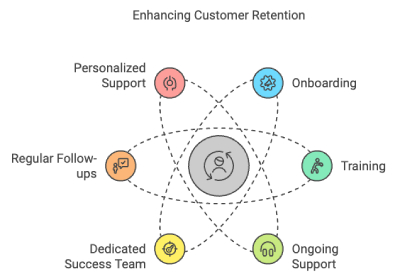 After the sale is completed, the priority becomes customer retention. Onboarding is an important step at this point; you need to provide comprehensive support to help the customer use your product effectively.
After the sale is completed, the priority becomes customer retention. Onboarding is an important step at this point; you need to provide comprehensive support to help the customer use your product effectively.
Offering training, ongoing customer support, and a dedicated customer success team can help deepen the relationship.
Providing regular follow-up and personalized support will reinforce the buyer’s confidence in their decision, keeping them engaged and satisfied, which increases the likelihood of future business and long-term loyalty.
Advocacy
The advocacy stage really means turning happy clients into brand champions through referral programs, case studies, and testimonials. Getting satisfied customers to share their stories reinforces your reputation while cultivating trust among potential prospective buyers.
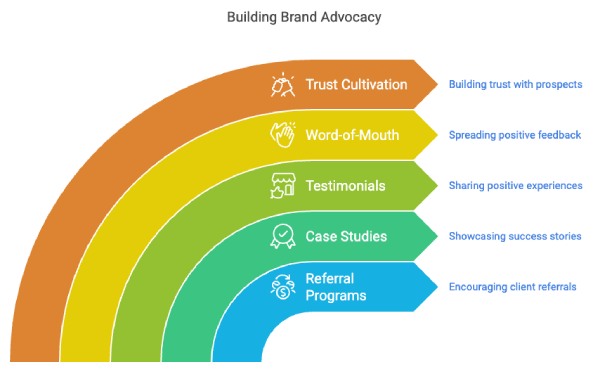
Positive word-of-mouth from loyal advocates helps attract new clients while creating long-term relationships with existing customers, reinforcing the cycle of growth and retention within your business.
Mapping the B2B Customer Journey
What is B2B Customer Journey Mapping?
Journey mapping visually represents all the touchpoints a customer interacts with during their complete buying process.
With a clear understanding of this journey, your business can recognize important interactions and build a more streamlined and effective customer experience, coordinating efforts across teams.
Why Journey Mapping Is Important In The Context Of B2B
 Through journey mapping, your business can identify important pain points, optimize your marketing efforts, and improve customer satisfaction overall.
Through journey mapping, your business can identify important pain points, optimize your marketing efforts, and improve customer satisfaction overall.
Having a well-structured map can help highlight areas for improvement, allowing for data-driven decisions that boost overall performance, streamline processes, and lead to stronger customer relationships and improved sales outcomes.
Steps To Creating An Effective B2B Customer Journey Map
1. Identify Buyer Personas
Start by understanding who your customers are. Taking the time to create accurate buyer personas helps you customize the customer journey map to reflect their unique needs and behaviors so your strategies effectively address their expectations.
2. Define Touchpoints & Channels
Pinpoint all the ways clients engage with your company, including browsing your website, engaging with your social media content, or communicating directly with your sales representatives.
3. Understand Customer Goals & Pain Points
Take the time to examine what your customers aim to achieve at each stage of their journey and identify the barriers that might prevent them from reaching their goals.
4. Map Out The Journey Stages
Carefully lay out each phase of the journey, from the initial awareness all the way through advocacy. Focus on the customer’s perspective, highlighting their experience and interactions throughout.
5. Identify Opportunities For Improvement
 Try to look for areas in the journey where processes can be improved or optimized to create a smoother, more satisfying customer experience.
Try to look for areas in the journey where processes can be improved or optimized to create a smoother, more satisfying customer experience.
Aligning your marketing efforts by understanding the stages and mapping the journey improves customer relationships, increases retention, and drives sustained customer loyalty.
Alongside this, continuously monitoring and updating your journey map keeps your strategies aligned with shifting customer needs to deliver sustained business growth.
Leveraging The B2B Customer Journey For Business Growth
Having a solid understanding of and attentive optimization of each step of the B2B customer journey helps you align your marketing and sales efforts to create a more personalized experience for your customers.
Let 321 Web Marketing guide you through every step of optimizing your B2B customer journey. Our expert team can help map out your customer’s experience, identifying essential touchpoints and opportunities for growth. Get started today and learn how we can improve your marketing strategy and drive real results.

